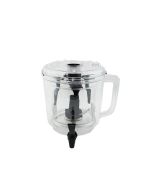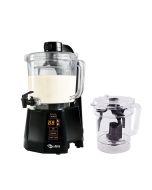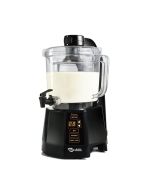Originally Posted on TheNutraMilk.com
By Florencia Tagliavini, Nutritionist
What exactly is zero waste?
The definition of zero waste varies with different organizations but it refers to redesigning our systems and use of resources (from product design to disposal) to prevent wasteful and polluting practices - at a large scale like various companies in different industries who are embracing zero waste practices to a smaller scale like your own kitchen at home.
"Essentially the movement is about choosing to follow a sustainable and plastic-free lifestyle by purchasing, creating and consuming sustainable products that do not have a negative impact on the environment. It goes beyond the environmentally-responsible efforts to reduce, reuse and recycle as it starts with Refuse then moves on to Reduce, Reuse, Recycle and ends with Rot", states kurbo-Bo, a company who contributes to zero waste by producing 100% natural charcoal water filters.
And more simply by www.goingzerowaste.com: "We aim to send nothing to a landfill. We reduce what we need, reuse as much as we can, send little to be recycled, and compost what we cannot".


Why?
The average American sends 4.4lbs of trash to the landfill every day. We live in a disposable society where we don't value our belongings, and we're consuming way too many resources.
Beyond our overconsumption problem, landfills are toxic. They're responsible for 20% of the methane emissions in the US, and they aren't aerated for the proper decomposition of natural materials. Toxins from cleaners, batteries, small electronics (and other items that shouldn't be landfilled) leach into the soil and can run off into the ocean and groundwater when it rains.
A lot of trash doesn't even make it to the landfill. Instead, it clutters the sides of roads and swirls in the ocean. Plastic is especially dangerous to the ocean, marine life, and our health. It doesn't biodegrade it photodegrades which means it only gets smaller and smaller".
Reducing, reusing and recycling can be a key part of a climate change strategy to reduce our greenhouse gas emissions, a way to conserve resources and minimize pollution for the safety of mankind, animals, plants and the survival of the planet.
What to do?
There are things that everyone can easily do to reduce their waste. And I think every little bit helps, we certainly need big changes in order to make a positive impact on the environmental degradation but I personally feel better doing my best to be part of the solution instead of contributing to the problem.
Let's take a look at the food we eat and how to take steps towards a more sustainable life in this area.
Shocking fact: According to the Food Waste Reduction Alliance, the United States wastes about 60 million metric tons of food a year, half of which ends up in landfills as a source of methane gas pollution. Some say the food wasted by developed countries is enough to feed the world's population of hungry people.
The first step is becoming conscious of how our everyday actions impact our environment. Making lifestyle changes can sometimes be overwhelming so start small- with just a few changes and as you become aware of where things come from and what happens to them afterwards and especially how much plastic we use, you can keep trying to make more changes to reduce waste in different areas of your life.
10 changes you can make towards zero waste in relation to food!
These steps were taken from a much more extensive list that The Zero-Waste Chef created, take a look at this website for more information.
- Bring your own cloth shopping bags. Opt for natural fibres when you choose bags. Synthetic materials shed tiny plastic fibers in the washing machine. This plastic ends up in our rivers, lakes and oceans. You can buy cloth shopping bags pretty much everywhere today. You can also buy them online from stores such as Ecobags and Life Without Plastic.
- Bring your own cloth produce bags. You won't want to stuff your reusable shopping bags with plastic produce and bulk bags.
- Refuse single-use plastic. Say no to plastic shopping bags; plastic straws and stir sticks; plastic utensils, plates and cups; and other disposable plastic items. This includes bottled water. According to www.earthday.org, ONE MILLION plastic bottles are bought EVERY MINUTE around the world, and that number will top half a TRILLION by 2021. Less than half of those bottles end up getting recycled.
- Choose fresh, seasonal fruit and vegetables. The best food for you - seasonal vegetables and fruit - is also best for the environment and economy when you buy it locally. It travels fewer miles. You can find much of it unpackaged. More of your money stays in your local community.
- Fill up at the bulk bins. Search for bulk stores worldwide at www.zerowastehome.com/app. Users can also submit stores not yet listed on this web-based app. Fill your reusable cloth bags, glass jars and other containers with staples like beans, rice, flour, oats, nuts, seeds, dried fruit and so on. Some bulk stores have an extensive selection that includes cleaning and personal care products and pet food.
- Hit the farmer's market. When you go plastic-free and zero-waste, you stop eating processed food - it's almost always packaged in shiny plastic wrapping. At farmer's markets, however, you'll find fresh, seasonal, local, organic produce that you can usually buy unpackaged.
- Cut out the processed food. Shop the perimeter of the grocery store, where you'll find produce, dairy, fish and meat counters. In the middle section (the aisles) you'll find only processed food and products wrapped in plastic packaging (think snacks and sodas, cereal and energy bars, canned vegetables and shelf-stable pickles). Cut the processed food and you've cut most of the plastic coming into - and out of - your kitchen.
- Make non-dairy milk. Nut milk and rice milk almost always come in wasteful Tetra Paks, made of several layers of materials, including plastic.
- Make more staples yourself. Yogurt, vanilla extract, chocolate syrup, and other foods usually packaged in plastic are easy to make. Other easy-to-make staples that usually come in either plastic or plastic-lined cans include scrap vinegar, beans (either in a pressure cooker or slow cooker), bean sprouts, pumpkin puree, etc.
- Compost. After you've finished preparing your meal, staples or fermented food, throw any unusable food scraps onto the compost pile. Some municipal compost bins require you to dispose of your compost in supposedly compostable plastic bags. You can however compost your food scraps at home with minimal effort. Here's how I compost the lazy way.
- Opt for glass food storage rather than plastic. Plastic food storage containers can range in colour from opaque to foggy clear plastic. When you store food in glass containers, you can see what's in the refrigerator or pantry at a glance and you're more likely to actually eat it rather than let it go to waste. Plus, glass won't come into contact with your food.
- Store produce without plastic. Use cloth produce bags, glass jars and glass containers. Some products, such as cauliflower, carrots, and cabbage don't need any special treatment. It can just roll around in your crisper drawer. Greens keep well in cloth produce bags. Store produce properly and you'll also reduce food waste.
- Freeze food without plastic. Use glass jars, cloth bags and metal containers. Take a few precautions, and you can safely freeze food in glass jars. Always leave headspace when freezing liquids. Be careful about how you stack jars in your freezer so they don't fall out when you open the door. To thaw, transfer your jar or container to the refrigerator the night before you need it.
- Ditch the plastic wrap. Want to cover a bowl of leftovers? Put a plate over it or cover it with a beeswax wrap, rather than a sheet of plastic wrap. You can make beeswax wraps or buy them.
- Ditch the plastic baggies. You have several alternatives, such as metal LunchBots and metal tiffins.






